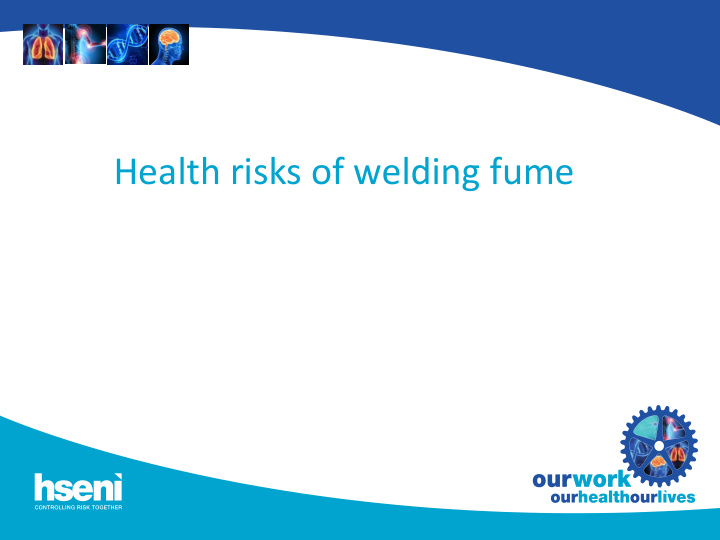



Health risks of welding fume
Re-classification of welding fume IARC Monograph on the Evaluation of Carcinogenic Risks to Humans Volume 118 Welding, Molybdenum Trioxide, and Indium Tin Oxide http://publications.iarc.fr/569
What are the substances of concern? • Metal fume from wire or rod • Vapours & gases produced during the welding process • Surface coatings and contaminants on the base metal
What are the health effects? • Acute (short term) – Metal fume fever • Chronic (long term) – Linked to Asthma – Elevated risk of lung cancers – COPD (current evidence suggest a link) – Increased susceptibility to pneumonia
Manual metal arc (MMA) • An arc is formed between parent metal and metal rod (electrode). The end of the rod melts in the heat of the arc • Molten metal particles are carried by the arc stream into the molten pool of parent metal, forming the filler of the weld • The rod has a flux coating which protects the weld from the surrounding atmosphere
MIG / MAG welding • An arc is formed between parent metal and a metal electrode in the form of a solid wire. The wire is fed at a steady rate through the centre of a welding gun. • A steady stream of gas flows around the metal electrode to protect the parent and molten weld metal from oxidising. • There are numerous mixes of shielding gases on the market, the choice of which depends upon its own specialist purpose.
Tungsten inert gas (TIG) welding • An arc is formed between parent metal to be welded and a metal electrode made from tungsten, which does not melt. • The joint may be made by melting the parent metal - autogenous welding (running in) or from a filler rod melted into the joint.
Fume levels of welding types and allied processes • Arc-air gouging very high • MMA / Stick high • Flame cutting moderate/high • MIG / MAG moderate • TIG low
Control measures • Local exhaust ventilation – Welding bench – On-gun extraction – Swing arm hoods – Flexible ducts – Mobile fume extractors • Respiratory Protective Equipment (RPE)
LEV Control – Welding Bench and On-gun Extraction
Respiratory Protective Equipment • RPE is required where residual fume may remain even after the use of Local exhaust ventilation • RPE must have a minimum assigned protection factor of 20 (e.g. FFP3)
Health Surveillance • Early detection of work related ill-health • Check on adequacy of control measures • Likely to be required when welding stainless steel where there is a known asthmagen e.g. chromium • Advice should be sought from an occupational health provider • Could include questionnaire and lung function test – (see G402 – Health surveillance for occupational asthma)
Moving forward • No one control solution will be effective for all cases (decisions informed by an assessment of risk) • Exposure controls required will be: – The provision of suitable engineering controls e.g. LEV for all welding fume inside – Any residual fume will require the use of RPE by operators – The provision of appropriate RPE for welding outdoors
Further information • BOHS Breathe Freely Campaign • BOHS Welding Fume Control Selector • IARC Welding Monograph • Video resources for health and safety in welding • HSENI / HSE webpages
Recommend
More recommend